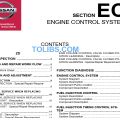Nissan Truck Pathfinder D21 Series Workshop Manual

Nissan TRUCK / PATHFINDER 1989 and 1990 Repair Manual
This manual contains maintenance and repair procedures for the 1989 and 1990 Nissan TRUCK and PATHFINDER. In order to assure your safety and the efficient functioning of the vehicle, this manual should be read thoroughly. It is especially important that the PRECAUTIONS in the Gl section be completely understood before starting any repair task. All information in this manual is based on the latest product information at the time of publication. The right is reserved to make changes in specifications and methods at any time without notice.
The proper performance of service is essential for both the safety of the technician and the efficient functioning of the vehicle. The service methods in this Service Manual are described in such a manner that the service may be performed safely and accurately. Service varies with the procedures used, the skills of the technician and the tools and parts available. Accordingly, anyone using service procedures, tools or parts which are not specifically recommended by NISSAN must first completely satisfy himself that neither his safety nor the vehicle's safety will be jeopardized by the service method selected.
The following precautions should be observed to ensure safe and proper service operations. These precautions are not described in each individual section.
- Do not operate the engine for an extended period of time without proper exhaust ventilation. Keep the work area well ventilated and free of any inflammable materials. Special care should be taken when handling any inflammable or poisonous materials, such as gasoline, refrigerant gas, etc. When working in a pit or other enclosed area, be sure to properly ventilate the area before working with hazardous materials. Do not smoke while working on the vehicle.
- Before jacking up the vehicle, apply wheel chocks or other tire blocks to the wheels to prevent the vehicle from moving. After jacking up the vehicle, support the vehicle weight with safety stands at the points designated for proper lifting and towing before working on the vehicle. These operations should be done on a level surface.
- When removing a heavy component such as the engine or transaxle/transmission, take care not to lose your balance and drop it. Also, do not allow it to hit against adjacent parts, especially brake tube and brake master cylinder.
- Before starting repairs which do not require battery power, always turn off the ignition switch, then disconnect the ground cable from the battery to prevent accidental short circuit.
- To prevent serious burns, avoid contact with hot metal parts such as the radiator, exhaust manifold, tail pipe and muffler. Do not remove the radiator cap when the engine is hot.
The 1989 models start production with the following vehicle identification numbers (chassis number) with the exception of those produced in U.S.A, produced trucks.
JN6HD11S*KW100001
JN6HD12S*KW100001
JN6HD16S*KW100001
JN6ND11S*KW100001
JN6ND12S*KW100001
JN6ND16S*KW100001
JN6HD12H*KW100001
JN6HD15H*KW100001
JN6HD11Y*KW100001
JN6HD16Y*KW100001
JN6ND11Y*KW100001
JN6ND12Y*KW100001
JN6ND16Y*KW100001
JN8ND16Y*KW100001
JN8HD16Y*KW100001
JN8HD14Y*KW100001
JN6ND14Y*KW100001
PERIODIC MAINTENANCE
The following charts show the normal maintenance schedule. Under severe driving conditions, additional or more frequent maintenance will be required. Refer to "Maintenance under severe driving conditions". The periodic maintenance schedule is repeated beyond the last mileage and period shown by returning to the first 15,000 miles (24,000 km) or 12 months.
MAINTENANCE UNDER SEVERE DRIVING CONDITIONS
The maintenance intervals shown on the preceding pages are for normal operating conditions. If the vehicle is mainly operated under severe driving conditions as shown below, more frequent maintenance is required to be performed on the following items as shown in the table.
GENERAL MAINTENANCE
General maintenance includes those items which should be checked during the normal day-to-day operation of the vehicle. They are essential if the vehicle is to continue operating properly. The owners can perform the checks and inspections themselves or they can have their NISSAN dealers do them for a nominal charge.
OUTSIDE THE VEHICLE
The maintenance items listed here should be performed from time to time, unless otherwise specified.
Tires Check the pressure with a gauge periodically when at a service station, including the spare, and adjust to the specified pressure if necessary. Check carefully for damage, cuts or excessive wear.
Doors and engine hood Check that all doors and the engine hood operate properly. Also ensure, that all latches lock LATCH securely. Lubricate if necessary. Make sure that the secondary latch keeps the hood from opening when the primary latch is released. When driving in areas using road salt or other corrosive materials, check lubrication frequently.












